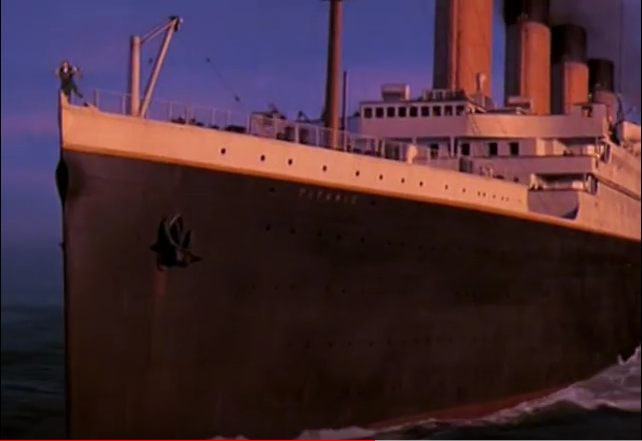ABOUT
Titanic is an American epic romance-disaster film directed, written, co-produced and co-edited by James Cameron, released in 1997. It is a fictional version based on the sinking of the RMS Titanic, starring Leonardo DiCaprio and Kate Winslet as two young people falling in love during the trip but who differ by their social status. The flying scene, accompanied by the iconic song My Heart Will Go On, is the most iconic scene of the movie and invites its audience to identify with the protagonists.
ANALYSIS OF THE SCENE
The scene starts with Jack Dawson (Leonardo DiCaprio) standing at the bow of the boat. Alternating between a bird’s eye view and a middle shot, the camera follows Jack who takes the role of the adventurous, but thoughtful character. The bird’s eye view enhancing the speed of the boat symbolises the exciting voyage as well as time flying by. However, the boat’s hull also reminds the viewer of the upcoming tragedy, as it will hit an iceberg in the near future.
Throughout the scene, there is an inimitable sunset that displays distinct colours such as pink, orange and purple. These colours are reflecting on the boat, the sea and the character’s faces, which gives magic to the situation. The colours symbolize happiness, and does not predict any danger. There is therefore a contrast between this sunset that announces warmth, with the coldness of the ocean, that will take Jack’s life.
The peacefulness of the scene is disrupted by the arrival of Rose (Kate Winslet), saying “Hello Jack”. As soon as she arrives, the song starts playing, which announces a turning point in the story. The tone of her voice also suggests she will change Jack’s destiny, which is confirmed when she adds: “I changed my mind”. Viewers understand that her heart chose Jack over her fiancé, Cal. Then, the alternation between close ups of Rose and Jack let the audience feel their emotions and energy, but also gives a certain kind of instability to their romance, which is a fragile young love.
These close ups accumulations are disrupted by Jack telling her to close her eyes, and helping her step onto the boat’s railing. Rose complied and does not contradict Jack in any way: she therefore gives him a sign of trust and of liberation. The close up of Rose and Jack’s faces is at a low angle and Rose is not at the centre of the frame anymore, he looks at her while she still has her eyes closed. This suggests a kind of control Jack has on her at this moment, which is enhanced when she frees her arm, that shows she gives him her complete trust.
The following bird’s eye view shot symbolises a disruption in time and action, as it copies the same shot as in the beginning of the scene, but this time, Jack is not alone and is holding his lover, Rose. This shot definitely shows a sense of freedom that the viewers as well as the characters know is only temporal: viewers know about Titanic’s fate and characters know their love is impossible due to their different social status.
The most iconic part of the scene is probably them two pretending to have wings. Rose then claims while still closing her eyes: “I’m flying… Jack”. This quote accompanied by the fact that Jack is standing behind Rose, who is completely letting herself go, makes us think that Jack rescued Rose from her life constrained by the pressure of social classes. The low angle also suggests they are in power, while their position implies freedom and control of the situation: they are leading the Titanic.

However, this is disrupted by the left of the image that lets appearing the part of the machine from the ship that reveals the ephemeral side to the moment, as the presence of the machine reminds us the upcoming crisis.
The extreme wide shot of the Titanic in which we can catch sight of the two protagonists, then tracks them and comes closer to them, moving delicately. Here, the filming is admirable, gives elegance to the scene, and highlights the lightness of their young love.
Rose is in this scene the main focus, she is the central point but is aided by Jack, that made all of this possible. She is most of the time at the centre of the frame, with Jack standing behind her. The extreme close ups of their two faces highlight their young love and innocence.

The end of the scene is highlighted by their passionate (first) kiss, which is intensified by the music, and by the camera circling around them. The fade in blue brings the viewer back to reality as it fades from this shot to the boat under the sea. This instantly plays with the emotions of the audience.















